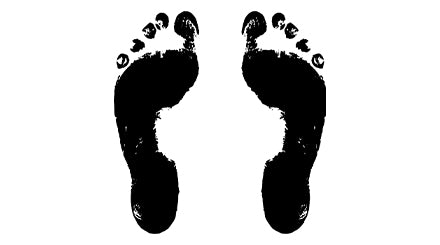
What's my arch type?
The "Wet" Test:
- Gather a shallow pan, a piece of heavy paper (i.e. shopping bag, etc.) and water.
- Remove your shoes.
- Place the pan on the floor.
- Place the piece of heavy paper, at a comfortable stepping distance, in front of the pan.
- Pour a few inches of water into the pan.
- Put one of your feet into the pan to get the sole wet.
- Step onto the paper with the wet foot.
- Step off the paper and observe your footprint.
Using the three images pictured below, match your footprint with one of the arch types. While other factors also affect your shoe choice (i.e. weight, biomechanics, purpose and fit/style preferences), being aware of your arch type is the first step to finding the perfect fitting shoe.

Normal (Medium) Arches:
If you can see about half of the arch, you have the most common type of foot and are known as a normal pronator. When your arch collapses inward, "pronation" absorbs the shock. With normal arches, almost any shoes will fit properly. However, stability shoes, providing moderate arch support, are a wise choice. Neutral-cushioned shoes, with no additional support, or performance-training shoes, with some support, are two good choices.

Flat (Low) Arches:
If your entire footprint is visible, you have low arches, meaning you likely "overpronate". In other words, the arch collapses too much, causing excessive foot movement that increases injury risk. For mild to moderate overpronators, "stability" shoes with features like dual-density midsoles and supportive "posts" for pronation reduction are the best choice. In the case of severe overpronators, motion-control shoes with firmer support devices are recommended, like many of the ones sold by Vionic with built in arch supports or, for insoles with the same capabilities, browse many of the options provided by Spenco.

High Arches:
If you observe just the heel, a thin line on the outer edge and the ball of the foot, you have high arches, the least common arch type. Typically, those with high arches are underpronators (i.e. supinators) meaning excessive shock travels up your legs because your arches do not sufficiently collapse to absorb the shock. Supinators should also wear neutral-cushioned shoes. They require a softer midsole, which encourages pronation. Lynco provides a wide range of gentle insoles, including ones specific ally targeted towards individuals with high arches. It is critical that shoes do not have any extra stability devices added that reduce or control pronation.
It is very important that you chose the correct arch supports and footwear for your feet, based on their natural arch. Doing so will result in optimum comfort as well as reducing the chances of experiencing any discomfort, pain and injuries of the feet, knees and back.
Basically, there are three types of foot arches: low, normal (medium) or high. A very simple "wet" test can be performed at home to assist you in determining what kind of arch you have. After completing this test, you will be able to choose the most appropriate type of arch supports and/or shoes for you.
